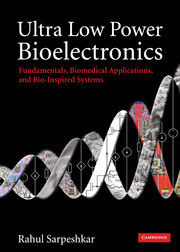Book contents
- Frontmatter
- Contents
- Acknowledgements
- Section I Foundations
- Section II Low-power analog and biomedical circuits
- 11 Low-power transimpedance amplifiers and photoreceptors
- 12 Low-power transconductance amplifiers and scaling laws for power in analog circuits
- 13 Low-power filters and resonators
- 14 Low-power current-mode circuits
- 15 Ultra-low-power and neuron-inspired analog-to-digital conversion for biomedical systems
- Section III Low-power RF and energy-harvesting circuits for biomedical systems
- Section IV Biomedical electronic systems
- Section V Principles for ultra-low-power analog and digital design
- Section VI Bio-inspired systems
- Section VII Energy sources
- Bibliography
- Index
- Epilogue
- References
15 - Ultra-low-power and neuron-inspired analog-to-digital conversion for biomedical systems
from Section II - Low-power analog and biomedical circuits
Published online by Cambridge University Press: 02 December 2010
- Frontmatter
- Contents
- Acknowledgements
- Section I Foundations
- Section II Low-power analog and biomedical circuits
- 11 Low-power transimpedance amplifiers and photoreceptors
- 12 Low-power transconductance amplifiers and scaling laws for power in analog circuits
- 13 Low-power filters and resonators
- 14 Low-power current-mode circuits
- 15 Ultra-low-power and neuron-inspired analog-to-digital conversion for biomedical systems
- Section III Low-power RF and energy-harvesting circuits for biomedical systems
- Section IV Biomedical electronic systems
- Section V Principles for ultra-low-power analog and digital design
- Section VI Bio-inspired systems
- Section VII Energy sources
- Bibliography
- Index
- Epilogue
- References
Summary
Although nature commences with reason and ends in experience, it is necessary for us to do the opposite; that is, to commence with experience and from this to proceed to investigate the reason.
Leonardo da VinciAn analog-to-digital converter converts real-world continuous analog signals into symbolic discrete digital numbers. It is often abbreviated as an ADC, A-to-D, or A/D. ADCs are ubiquitous in all electronic systems. A digital-to-analog converter performs the inverse function and is correspondingly abbreviated as a DAC, D-to-A, or D/A. Figure 15.1 shows the input-output curve of an ADC. The input and output are equal to each other within a quantization error of ± Δ/2, a consequence of the fact that we need to round up or round down real numbers to the nearest integer to represent them digitally. The digital numbers are usually represented with binary digits or bits. If, because of the input statistics, any error between [-Δ/2, + Δ/2] is equally likely, then, from evaluation of the second moment of a flat probability distribution, the rms error of the quantized representation of a real number can be shown to be Δ2/12. If the ADC samples its input at a sampling frequency fS, the power spectrum of the quantization noise is well approximated as being white from 0 to fS/2 and therefore having a noise per unit bandwidth of Δ2/(12(fS/2)).
Information
- Type
- Chapter
- Information
- Ultra Low Power BioelectronicsFundamentals, Biomedical Applications, and Bio-Inspired Systems, pp. 385 - 418Publisher: Cambridge University PressPrint publication year: 2010
